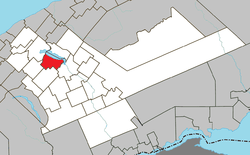Val-Brillant, Quebec
| Val-Brillant | |
|---|---|
| Municipality | |
|
| |
 Location within La Matapédia RCM. | |
 Val-Brillant Location in eastern Quebec. | |
| Coordinates: 48°32′N 67°33′W / 48.533°N 67.550°WCoordinates: 48°32′N 67°33′W / 48.533°N 67.550°W[1] | |
| Country |
|
| Province |
|
| Region | Bas-Saint-Laurent |
| RCM | La Matapédia |
| Settled | 1872 |
| Constituted | December 20, 1986 |
| Government[2] | |
| • Mayor | Donald Malenfant |
| • Federal riding |
Haute-Gaspésie—La Mitis—Matane—Matapédia |
| • Prov. riding | Matane-Matapédia |
| Area[2][3] | |
| • Total | 90.90 km2 (35.10 sq mi) |
| • Land | 77.60 km2 (29.96 sq mi) |
| Population (2011)[3] | |
| • Total | 955 |
| • Density | 12.3/km2 (32/sq mi) |
| • Pop 2006-2011 |
|
| • Dwellings | 501 |
| Time zone | EST (UTC−5) |
| • Summer (DST) | EDT (UTC−4) |
| Postal code(s) | G0J 3L0 |
| Area code(s) | 418 and 581 |
| Highways |
|
| Website |
www |
Val-Brillant is a municipality in eastern Quebec, Canada, at the base of the Gaspé peninsula. On the southern shores of the Lake Matapedia, Val-Brillant is part of the Matapédia Valley.
The place was previously known by many other names: Lac-Matapédia; Brochu or Brouché, followed by Lac-à-Brochu until 1871 (after Pierre Brochu (1795-1871), the first settler in the valley in what is now Sayabec); McGowe (after an engineer working on the railroad); Cedar Hall from 1876 to 1912 (referring to the large hanger built from pieces of cedar that served as a coal shed for the railway); and Saint-Pierre-du-Lac (in honour of Pierre Brillant (1852-1911), missionary in the Matapedia Valley from 1881 to 1889 and parish priest from 1889 to his death).[1]
History
Originally Mi'kmaq territory, the area was granted as a seignory by Louis de Buade de Frontenac to Charles-Nicolas-Joseph D’Amours in 1694. D'Amours died in 1728 and none of his descendants claimed the rights to the seignory. So it remained a remote and undeveloped land until the 19th century. In 1830 construction began on the Kempt Road, a strategic military road between Quebec and the Maritimes, completed in 1833. An inn serving postilions and travelers along the road operated there from 1867 to 1876.[4]
European settlement began in 1872 during the construction of the Intercolonial Railway. Supervisor Engineer Peter Grant built for himself a house that also accommodated the railway employees for many years. In 1876, the railway was completed and on July 1 the first train passed through. In 1881, the post office opened, and two years later, the Mission of Saint-Pierre-du-Lac was established, named in honour of Pierre Brillant. In 1890, the Parish Municipality of Saint-Pierre-du-Lac was founded. By 1898, it had a population of 1600 people.[1][4]
In 1915, the main population centre separated from the parish municipality and was incorporated as the Village Municipality of Saint-Pierre-du-Lac, but renamed one year later to Val-Brillant.[1]
In 1986, the Village Municipality of Val-Brillant and the Parish Municipality of Saint-Pierre-du-Lac were rejoined in the current Municipality of Val-Brillant.[1]
Municipal council
- Mayor: Donald Malenfant
- Councillors: Serge Malenfant, Gérald Ouellet, Roch Couture, Yves Bilodeau, Jacques Gaulin, Geneviève Leblanc
Demographics
| |||||||||||||||||||
See also
References
- ↑ 1.0 1.1 1.2 1.3 1.4 "Val-Brillant (Municipalité)" (in French). Commission de toponymie du Québec. Retrieved 2012-01-26.
- ↑ 2.0 2.1 "Val-Brillant". Répertoire des municipalités (in French). Ministère des Affaires municipales, des Régions et de l'Occupation du territoire. Retrieved 2012-01-26.
- ↑ 3.0 3.1 3.2 "Val-Brillant census profile". 2011 Census data. Statistics Canada. Retrieved 2012-01-26.
- ↑ 4.0 4.1 "Historique" (in French). Municipalité de Val-Brillant. Retrieved 2012-01-26.
- ↑ 5.0 5.1 "Electronic Area Profiles". Canada 1996 Census. Statistics Canada. Retrieved 2013-05-12.
- ↑ "2006 Community Profiles". Canada 2006 Census. Statistics Canada. March 30, 2011. Retrieved 2012-01-26.
- ↑ "2001 Community Profiles". Canada 2001 Census. Statistics Canada. February 17, 2012. Retrieved 2012-01-26.
External links
- Bibliothèque et Archives Nationales du Québec - Cedar Hall (French)
- Info Gaspésie - Val-Brillant
| Wikimedia Commons has media related to Val-Brillant. |
 |
Sayabec | Lac-Matapédia |  | |
| |
||||
| ||||
| | ||||
| Saint-Cléophas | Sainte-Irène | Amqui |
| ||||||||||||||||||||||||||